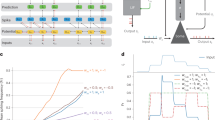Abstract
In this Letter, a new approach to build a neural model for the fast identification of spatiotemporal sequences is proposed. Such a model, the Stochastic Neural Sequence Identifier (SNSI), is simple and rapidly learns and identifies a given sequence. The SNSI receives as input several patterns belonging to a particular spatiotemporal sequence and produces as output a label for the sequence identified and a probability of this classification being correct. The SNSI is able to identify a sequence from patterns learned during training or novel ones, i.e., combinations of the sequence items distinct from those belonging to the trained set. The SNSI was tested on a 2D set of both closed and open trajectories with varying levels of complexity. The results suggest that the SNSI is able to recognize all the patterns presented in the training and most of the novel patterns used for testing.
Similar content being viewed by others
Explore related subjects
Discover the latest articles, news and stories from top researchers in related subjects.References
AraÚjo, A. F. R. and de A. Barreto, G.: Context in temporal sequence processing: A selforganizing approach and its application to robotics, IEEE Transactions on Neural Networks, 13(01) (2002), 45-57.
de A. Barreto, G. and AraÚjo, A. F. R.: Time in self-organizing maps: An overview of models, International Journal of Computer Research, 1(2) (2001), 235-259.
Campolucci, P., Uncini, A., Piazza, F., and Rao, B. D.: On-line learning algorithms for locally recurrent neural networks, IEEE Transactions on Neural Networks, 10(2) (1999), 253-271.
Funahashi, K. I. and Nakamura, Y.: Approximation of dynamical systems by continuous time recurrent neural networks, Neural Networks, 6 (1993), 801-806.
Galicki, M., Leistritz, L. and Witte, H.: Learning continuous trajectories in recurrent neural networks with time-dependent weights, IEEE Transactions on Neural Networks, 10(4) (1999), 741-756.
Montague, R. and Sejnowski, T. J.: The predictive brain: Temporal coincidence and temporal order in synaptic learning mechanisms, Memory & Learning, 1 (1994), 1-33.
Srinivasa, N. and Ahuja, N.: A topological and temporal correlator network for spatiotemporal pattern learning recognition, and recall, IEEE Transactions on Neural Networks, 10(2) (1999), 356-371.
Hertz, J., Krogh, A. and Palmer, R. G.: Introduction to the Theory of Neural Computation. Addison-Wesley: Redwood City, CA, USA, 1991.
Bradski, C. A., Carpenter, G. and S. Grossberg, S.: Working memory networks for learning temporal order with application to three-dimensional visual object recognition, Neural Computation, 4(2) (1992), 279-286.
Mandler, J.: On the comprehension of temporal order, Language and Cognitive Processes, 1(4) (1986), 309-320.
Wang, D. L. and Arbib, M. A.: Timing and chunking in processing temporal order, IEEE Transactions on Systems, Man, and Cybernetics, 23(4) (1993), 993-1009.
Pearlmutter, B.: Gradient calculations for dynamic recurrent neural networks, IEEE Transactions on Neural Networks, 6(5) (1995), 1212-1228.
Campolucci, P., Uncini, A., Piazza, F. and Rao, B.D.: On-line learning algorithms for locally recurrent neural networks, IEEE Transactions on Neural Networks, 10(2) (1999), 253-271.
Henriques, A.S. and AraÚjo, A.F.R.: A neural module to estimate context information for sequence learning, In: Proceedings of the 2001 IEEE International Joint Conference on Neural Networks, pp. 1646-1651, Washington, DC, USA, 2001.
Kohonen, T.: Self-Organizing Maps, 2nd edition, Springer: Berlin, Germany, 1997.
Jordan, M.I.: Attractor dynamics and parallelism in a connectionist sequential machine, In: Proceedings of the 8th Annual Conference of the Cognitive Scicences Society, pp. 531-546, Amherst, MA, 1986.
Elman, J.L.: Finding structure in time, Cognitive Science, 14 (1990), 179-211.
Hinton, G.E. and Sejnowski, T.J.: (eds.), Unsupervised learning: Foundations of Neural Computation, MIT Press: Cambridge, MA, USA, 1999.
Kaski, S., Kangas, J. and Kohonen, T., Bibliography of self-organizing map (SOM)-Papers: 1981-1997, Neural Computing Surveys, 1 (1998), 102-350.
Somervuo, P. and Kohonen, T.: Self-organization maps and learning vector quantization for feature sequences, Neural Processing Letters, 10 (1999), 151-159.
Lee, K.Y., McLaughlin, S. and K. Shirai, K.: Speech enhancement based on neural predictive hidden Markov model, Signal Processing, 65 (1997), 373-381.
Haykin, S.: Neural Networks-A Comprehensive Foundation. Prentice Hall: New Jersey, USA, 1999.
Miller, D., Rao, A.V., Rose, K. and Gersho, A.: A global optimization technique for statistical classifier design'', IEEE Transactions on Signal Processing, 44(12) (1996), 3108-3122.
Rose, K.: Deterministic annealing for clustering, compression, classification, regression, and related optimization problems, Proceedings of the IEEE, 86(11) (1998), 2210-2239.
Author information
Authors and Affiliations
Rights and permissions
About this article
Cite this article
Araújo, A.F.R., Henriques, A.S. A Stochastic Neural Model for Fast Identification of Spatiotemporal Sequences. Neural Processing Letters 16, 277–292 (2002). https://doi.org/10.1023/A:1021703615985
Issue Date:
DOI: https://doi.org/10.1023/A:1021703615985




